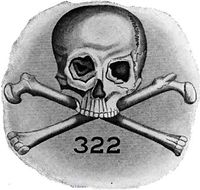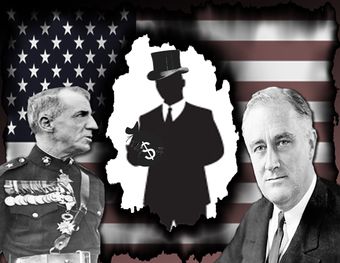The Money Trust
(Deep state faction) | |
|---|---|
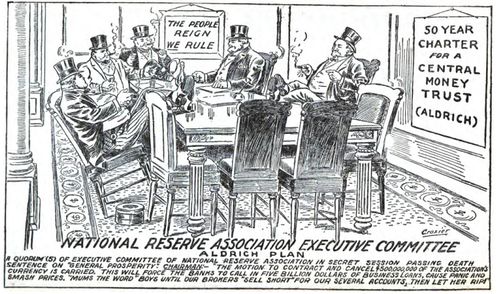 | |
| Extinction | 1939 |
| Headquarters | New York? |
| Interest of | Charles August Lindbergh, Ferdinand Lundberg, Pujo Committee, Arsène Pujo |
| Founder of | US/Federal Reserve |
| Membership | • • • Henry P. Davison • • • Charles D. Norton • • James Stillman • Frank E. Peabody • William Rockefeller • Benjamin Strong • • 40px Felix Warburg • Paul Warburg |
| The US deep state of the late 19th and early 20th century. After taking control of the US dollar through the Federal Reserve Act, they proceeded on an aggressive project of self-enrichment, leading ultimately to World War II. | |
The Money Trust (also called The Money Power) was a cabal of bankers at the heart of the US Deep state around a century ago. Their control over the US government was evidenced by their capture of the immense profits stemming from control of the US dollar. This moved from public to private ownership in 1913 with the passing of the Federal Reserve Act. These allowed the group to further tighten their control over Wall St and the US economy, leading eventually to the great depression of the 1930s during which they staged a failed fascist coup, The Business Plot. Although successful at avoiding prosecution, this damaged their credibility as an effective state, and World War II was to shift the locus of power towards the Georgetown Set and its associated intelligence agencies.
Contents
Origins
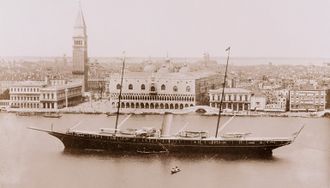
The deep state milieux used by The Money Trust we more local and transient, less international than those use by modern deep state factions, reflecting the restricted travel options available. Dining clubs were popular in the US. A very important exception to their parochial nature was The Pilgrims Society, which was also relevant to the UK deep state.
The Pilgrims Society
- Full article: The Pilgrims Society
- Full article: The Pilgrims Society
The Pilgrims Society, begun in 1902 in UK, is an internationaldeep state milieu populated largely by financiers. On 13 January 1903 at the Waldorf Astoria Hotel in New York, a US chapter was inaugurated, which continues to this day and has a reciprocal membership arrangement with the UK group.
Skull and Bones
- Full article: Skull and Bones
- Full article: Skull and Bones
Skull and Bones, a secret society at Yale University was important in the development of The Money Trust, as were others to a lesser extent. In the 1880s the group set up the American Historical Association and the American Economic Association to help control the narrative and hide their influence.[1]
Sullivan & Cromwell
- Full article:
 Sullivan & Cromwell
Sullivan & Cromwell
- Full article:
Sullivan & Cromwell, the New York based law firm, did important work for The Money Trust, a relationship which went at least as far back as 1882 when they assisted J. P. Morgan in the establishment of Edison General Electric and in 1901 assisted in the formation of U.S. Steel.[2]
Cromwell developed the concept of a holding company, which The Money Trust helped introduce into the law of the state of New Jersey. This was effective in reducing the effectiveness of antitrust laws.[3]
Activities
1900s
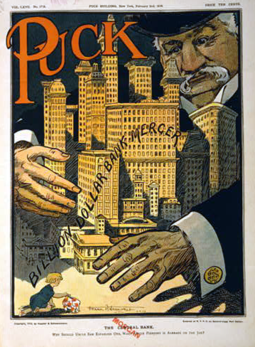
The activities of the Money Trust were focused not only on self-enrichment, but on securing their privilege by using control of the US government to implement legal protections. Often they were duplicitous in playing both sides and misrepresenting their purposes.
Control of Woodrow Wilson
Edward Mandell House was Woodrow Wilson's handler for The Money Trust. He was so close to Wilson that he lived at the White House for some time, and managed the US President on their behalf.
1907 Panic
- Full article: 1907 Panic
- Full article: 1907 Panic
The Money Trust organised the 1907 Panic. This strengthened their control over Wall St by enriching the trust's members, who had advance warning, and by impoverishing or bankrupting others, notably Frederick Heinze who was not member of the cabal.[4]
1910s
The Aldrich Plan
- Full article: The Aldrich Plan
- Full article: The Aldrich Plan
The Aldrich Plan aimed to wrest control over the production of money from the US government and place it under control of The Money Trust. It was defeated.
1913 Federal Reserve Act
- Full article: Federal Reserve Act
- Full article: Federal Reserve Act
After the failure of The Aldrich Plan, the money trust arranged for the 1910 Jekyll Island meeting to devise an alternative. This rebranded it as the Federal Reserve System, which paid more attention to the appearance of federalisation, but was essentially similar. Some Money Trust members publicly opposed it, in order to hide this fact. The Federal Reserve Act was passed just before Christmas, 1913, when many senators had already gone home for Christmas. This was a crucial step in the rise of The Money Trust, as it granted a high degree of control over the US economy, allowing for the creation of events such as The Great Depression.
1920s
The Great Depression
- Full article:
 Great Depression
Great Depression
- Full article:
The Great Depression was created by manipulation of the US money supply which post-1913 was under the control of The Trust. Inflation of money in circulation lead to the "roaring 20s", which ended abruptly in 1929 when the creation of currency was tightened.[citation needed] After a decade of financial hardship, WW2 shook up the old order. Post WWII, the Georgetown Set set up the OPC and CIA, peacetime replacements for the more ad hoc wartime intelligence agencies and institutionalisations of the Cold War permanent war mentality.
1930s
In the 1930s, fascism was on the rise in Europe, an attractive development in the eyes of some leaders of large corporations and members of The Money Trust. The failure -- and in particular the exposure -- of The Business Plot lead to an eclipse of the group's importance as the Suite 8F Group assumed more importance.
The Business Plot
- Full article: The Business Plot
- Full article: The Business Plot
In 1933 a bond trader, Gerald MacGuire, approached General Smedley Butler, to sound him out for a role as a potential figurehead for a military coup, to be carried out on grounds of FDR's failing health. Butler, however,wanted no part of it, but successfully feigned interest in order to gathered evidence. He later presented to the McCormack-Dickstein Committee.[5] Once alerted to the coup plan, FDR apparently cut a secret deal with the leaders: they would back his new deal and in return he halted the investigation and censored the names of the plot's leaders. The money trust used their considerable influence to try to erase the evidence which had emerged. As a result, the plot is relatively little known today, but the power of The Money Trust was greatly weakened.
Sudden death of Bronson Cutting
Bronson Cutting was a US senator highly critical of The Money Trust and their sate sanctioned monopoly over credit creation. He published an article in the March 31, 1934 issue of Liberty magazine entitled "Is Private Banking Doomed?", answering in the affirmative.[6] He died in a plane crash on May 6, 1935, between Albuquerque and Washington, D.C, as recorded by Time Magazine in an accident due to thick fog.[7]
Leadership
At least in terms of wealth, J. P. Morgan led The Money Trust, until his death in 1913, when quite possibly leadership passed into the hands of other members of his Corsair Club.
Exposure
The exposure of The Money Trust began in 1912 with the Pujo Committee.
Pujo Committee
- Full article: Pujo Committee
- Full article: Pujo Committee
The chair of the House Committee on Banking and Currency, Representative Arsène Pujo convened a special committee (the Pujo Committee) to investigate a "money trust". After the committee investigated from 1912 to 1913, it issued a scathing report on the banking trade, and found that the officers of J.P. Morgan & Co. also sat on the boards of directors of 112 corporations with a market capitalization of $22.5 billion (the total capitalization of the New York Stock Exchange was then estimated at $26.5 billion).[8] Their report unanimously declared that a small cabal of financiers had gained consolidated control of numerous industries through the abuse of the public trust.
Events carried out
| Event | Location | Description |
|---|---|---|
| 1907 Panic | John D. Rockefeller and J. P. Morgan conspired to remove opposition to control of the US money system by the money trust. | |
| 1910 Jekyll Island meeting | US 1910 Jekyll Island meeting | A secret meeting at Jekyll Island, attended by six men who conspired to privatise the US money system for control of the "money trust". |
| Federal Reserve Act | The 1913 law which secured operational control of the US dollar for the US Deep state up to the present day. |
Related Quotations
| Page | Quote | Author | Date |
|---|---|---|---|
| Federal Reserve Act | “The Republican leader did not know what was in the Act nor was he given the opportunity to find out what was in the Act. Later in debate Bristow directly accused Owen of inserting provisions for the profit of his own bank.
There were major abuses of the legislative process in the passage of the Federal Reserve Act - sufficient to void the act. If we have a society that lives by rules then there is no Federal Reserve Act. Both Finance Committee Chairmen, Congressman Glass and Senator Owen, had conflict of interest with personal banking interests and stood to gain from the bill. Meetings to discuss the bill were held without knowledge of committee members. Decisions were arrived at and established without the knowledge and agreement of members. Major sections of the bill were settled without consultation and railroaded into final form. There is indisputable evidence of outside banking influence upon Congress.” | Antony Sutton | |
| Ferdinand Lundberg | “The United States is owned and dominated today by a hierarchy of its sixty richest families... These families are the living center of the modern industrial oligarchy which dominates the United States, functioning discreetly under a democratic form of government behind which a de facto government, absolutist and plutocratic in its lineaments, has gradually taken form since the Civil War. This de facto government is actually the government of the United States — invisible, shadowy. It is the government of money in a dollar democracy.” | Ferdinand Lundberg | 1937 |
| Louis McFadden | “Mr. Chairman, we have in this country one of the most corrupt institutions the world has ever known. I refer to the Federal Reserve Board and the Federal reserve banks. The Federal Reserve Board, a Government board, has cheated the Government of the United States out of enough money to pay the national debt. The depredations and the iniquities of the Federal Reserve Board and the Federal reserve banks acting together have cost this country enough money to pay the national debt several times over. This evil institution has impoverished and ruined the people of the United States; has bankrupted itself, and has practically bankrupted our Government. It has done this through defects of the law under which it operates, through the maladministration of that law by the Federal Reserve Board and through the corrupt practices of the moneyed vultures who control it. From the Atlantic to the Pacific our country has been ravaged and laid waste by the evil practices of the Federal Reserve Board and the Federal Reserve banks and the interests which control them … This is an era of economic misery, and for the conditions that caused that misery, the Federal Reserve Board and the Federal Reserve banks are fully liable. | Louis McFadden | 1934 |
| Woodrow Wilson/Deep state control | “This Wall Street cabal, with the aid of New Jersey political bosses, pushed for Woodrow Wilson to become Governor of New Jersey in November, 1910.
Within a few months, Cleveland Dodge opened a bank account in New York and an office at 42 Broadway to boom Wilson into the Presidency. The campaign bank account was opened with a check for $1,000 from Cleveland Dodge. Dodge then provided funds to mail out the True American of Trenton, New Jersey to 40,000 subscribers throughout the United States, followed by a regular two pages a week of promotional material on Wilson For President. Two-thirds of Wilson's campaign funds for the presidency came from just seven individuals, all Wall Streeters and linked to the very trusts Wilson was publicly denouncing.” | Antony Sutton |
Known members
13 of the 14 of the members already have pages here:
| Member | Description |
|---|---|
| Nelson Aldrich | US Deep state operative, member of The Money Trust, attended the 1910 Jekyll Island meeting |
| George Fisher Baker | The "Dean of American Banking", 3rd richest US citizen at his death |
| Henry Davison | USDSO and banker who attended the 1910 Jekyll Island meeting |
| Edward Mandell House | Woodrow Wilson’s handler |
| J. P. Morgan | Ultra wealthy US deep politician whose The Money Trust ruthlessly dominated corporate finance and industrial consolidation there for decades. |
| Charles Norton | USDSO |
| Frank Peabody | Named by the Pujo Committee as a member of The Money Trust |
| William Rockefeller | Co-founded Standard Oil in 1870 with his more infamous brother, John D. Rockefeller. |
| Jacob Schiff | US banker businessman and deep politician |
| Benjamin Strong | Member of The Money Trust, Governor of the Federal Reserve Bank of New York for the first 14 years of the Fed's existence |
| Frank Vanderlip | Member of The Money Trust |
| Felix Warburg | Super wealthy financier and deep politician. |
| Paul Warburg | US deep politician named in the report of the Pujo Committee. Brother of Max Warburg. |
Events Planned
| Event | Start | End | Location(s) | Description |
|---|---|---|---|---|
| Great Depression | 1929 | 1939 | US | A huge impoverishment of the US citizens, resulting from market manipulations by The Money Trust |
| The Business Plot | 1933 | 1934 | A military takeover of the USA planned by The Money Trust. Never enacted due to the character of the man they ill advisedly chose to head it Smedley Butler, who foiled the plot and decreased the group's influence. |
Related Document
| Title | Type | Publication date | Author(s) | Description |
|---|---|---|---|---|
| File:The Federal Reserve conspiracy by Antony C Sutton.pdf | book | Antony Sutton | Historical perspectives on the money trust including critique of Karl Marx |
References
- ↑ America's Secret Establishment
- ↑ "Giant Steel Trust Launched at Last: Will be Known as the United States Steel Corporation," The New York Times, February 26, 1901
- ↑ Harnessing the Growth of Corporate Capitalism: Sullivan & Cromwell and its influence on late Nineteenth-century American business,” by Jason Weixelbaum; paper posted December 25, 2010
- ↑ https://www.unwelcomeguests.net/750_-_Black_Is_The_New_White
- ↑ http://www.unwelcomeguests.net/229
- ↑ 73rd Congress, 1st session, May 4?, 1935. US Congressional Record.
- ↑ http://content.time.com/time/magazine/article/0,9171,754759,00.html
- ↑ Bruner & Carr 2007, p. 148
